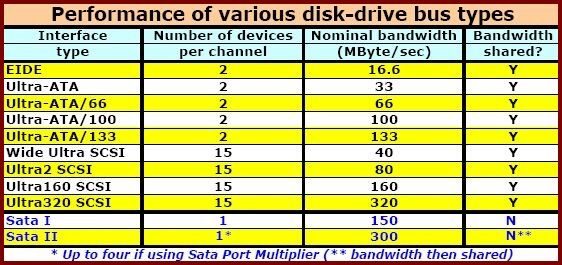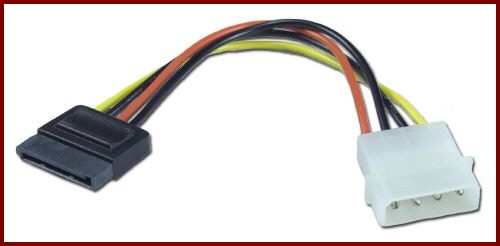Downsides of Parallel ATA & SCSI
Pata has been through various incarnations, increasing in bandwidth every few years. In Pentium I days, it was capable of 16.6MByte/sec, but this was raised using DMA modes to 33MByte/sec via the Ultra-ATA standard. Then came Ultra-ATA/66 with 66MByte/sec and Ultra-ATA/100 with 100MByte/sec.Some motherboard makers have moved to using Ultra-ATA/133, offering 133MByte/sec bandwidth. Maxtor is the main supporter of this upgraded form of Pata – Hitachi has remained with Ultra-ATA/100. Since Ultra-ATA/66, the cable changed from 40 wires to 80, although the extra wires operate through the same 40-pin connector as before for backwards compatibility.
However, all these Pata performance figures are nominal. In reality, no form of Pata can sustain its maximum rated throughput. Maxtor, for example, admits that Ultra-ATA/133 can only achieve 85 per cent of its bandwidth, and even then only in burst mode. The overhead from control signalling reduces the real figure considerably.
And, though a single Pata channel can usually support two devices – typically configured as master and slave - they have to share the channel’s bandwidth, though this currently isn’t a major problem.
Few hard disks exceed 50MByte/sec average sustained data transfer rate and the interface can cope with around 100MByte/sec. But there’s clearly not much future left for Pata when Ultra-ATA/133 maxes out at a little over 110MByte/sec.
A few Pata drives are able to sustain well over 50MByte/sec, such as Western Digital’s Raptor, Seagate’s 200GByte Barracuda 7200.7 and Maxtor’s DiamondMax 10. Other makers will follow with their next-generation models.
So anyone planning to use more than one disk on a single ATA channel, particularly in a Raid configuration, will discover that Pata isn’t up to the job.

applications, it will be dedicated to a single drive – giving it the drop on SCSI, too
Traditionally, the way around the Pata bottleneck has been to use SCSI, the Small Computer Systems Interface. Although SCSI is also a parallel connection, each new version has kept it way ahead of Pata.
As well as having a higher nominal bandwidth than Pata, SCSI has had intelligent circuitry in its adapters and drives that meant that most of the throughput could be used.
The current fastest SCSI standard, Ultra320, offers 320MByte/sec. However, like Pata, that’s shared between all the devices on the SCSI channel.
But there can be up to 15 devices on a single SCSI connection, all sharing the 320MByte/sec, so the SCSI bus itself will start to be the limiting factor if more than five fast disks are attached such as Seagate’s Cheetah X15 15,000rpm model.
SCSI also carries a big price premium – the disks can be four or five times more expensive than their Pata or Sata equivalents, and faster adaptors aren’t cheap either.
Although Sata’s nominal 150MByte/sec is slightly better than the bandwidth of Ultra-ATA/133, that’s not the only reason why it has a rosy future ahead of it.
No less important is that Sata’s 150MByte/sec is dedicated to just one device – and no current Sata hard disks require even half that.
The fastest Sata drive currently available, Western Digital’s 10,000rpm Raptor, averages 65MByte/sec, so it will be a while before any disk starts to push the limits of Sata - by then there will be a new Mk II version, as detailed below.
The data and power cabling for Sata is completely different to Pata. Although the many Sata drives include the standard Molex power connector for backwards compatibility, there is a new Sata power plug that, like the Sata data connection, is an entirely new in-line format.
For those disks without a Molex power connector, it’s necessary to use Molex-to-Sata power adapters or a PC power supply with Sata power plugs.

On a hard drive, the two new connectors sit side-by-side to simplify use with slide-in disk caddies. Understandably, though, many makers of servers and other high-end systems consider the connectors too fragile for this kind of use.
Sata has potentially huge benefits for Raid, compared with SCSI. Each Sata disc has its own dedicated 150MByte/sec pipe, so a Sata Raid set up doesn’t suffer the same limitations of SCSI Raid systems where all drives have to share 320MByte/sec of bandwidth.
Unfortunately, though, with Sata, the bottleneck shifts to the motherboard’s PCI bus. That’s why most current Sata Raid adapters - particularly those with four or more ports - use PCI-X, the 64-bit (but still parallel) version of PCI that offers many times the bandwidth of standard PCI.
Most of these adapters can also be used in PCI slots, but are then limited to PCI’s 133MBytes/sec ceiling.









